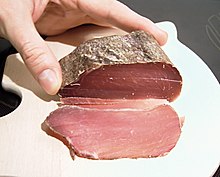Dried meat
Jerky or jerky meat is air- dried meat that can be made from both raw and heated meat or meat products. The methods used today are - in addition to traditional air drying - the hot air flow (40 - 60 ° C), vacuum drying (hot fat) or gentle freeze drying . It is essential that water is removed evenly throughout the product, not just on the surface. Dried meat has less than 10% water content, in comparison air-ripened, air-dried, long-ripened, naturally-ripened and similar Ä. Ham between 60 and 70% water content.
Drying reduces the a w value to such an extent that molds and yeasts can no longer multiply. Rehydrability , aroma and water retention are important criteria for a high quality end product; fat oxidation and the Maillard reaction limit the shelf life. Rehydrated dried meat comes closer to fresh meat in terms of taste and sensory quality, the better the quality of the raw material and the drying conditions. Better quality is obtained from meat that is warm at slaughter than from meat after rigor mortis, as it has excellent water-binding properties.
Regional types of dried meat
In South Africa there is biltong made from game or beef, which is primitively dried on wooden racks in the air and in the sun. Other dried meat products are pemmican from North America, in Portugal and Brazil there is the Carne seca and Carne de Sol , Tassajo in Uruguay, Dendeng in the Malays, in the rest of South America Charqui , in Turkey Pastırma . Furthermore, the Lower Saxon nail meat and the Thuringian Landjäger are known. Bündnerfleisch is actually not dried meat, as it still contains 45% water.
It can be pieces of meat that have been dried whole and cut into slices or smaller pieces before consumption. Another option is to cut the meat into strips before it is dried, which allows for faster drying and results in ready-to-eat dried meat.
Raw pieces of meat (e.g. beef , pork , sheep , goat , game or horse ) are dried by storing them in a mixture of salt , herbs and spices and then hanging up to dry for a few days or weeks. Large parts such as ham dry for up to a year and a half. The weight loss can be 40 to 50%, sometimes even more. The typical aromas develop over time , including the noble mold that forms on the surface of each piece.
Dried meat was once a staple food for mountain farmers in Europe . It has now become one of the most expensive cuts of meat. In the Swiss region of Valais , people are proud of the regional Valais dried meat , which there is only made from beef , similar to Bündnerfleisch or Veltliner Bresaola . The indication Valais dried meat is protected.
The method of preserving meat by drying is also widespread in other areas of the world. In Spain, for example, the cecina is known. The American beef jerky consists of previously marinated, dried strips of meat. In Mongolia, yak meat is processed into borts .
- Traditional dried meat production in the canton of Graubünden
See also
Web links
Individual evidence
- ↑ a b Heike P. Schuchmann, Harald Schuchmann: Food process engineering : raw materials, processes, products . John Wiley & Sons, 2012, ISBN 978-3-527-66054-4 ( google.de [accessed October 13, 2019]).
- ↑ J. Schormüller: Textbook of food chemistry . Springer-Verlag, 2013, ISBN 978-3-642-65778-8 , pp. 333 ( google.de [accessed on October 13, 2019]).
- ↑ a b J. Schormüller: Textbook of food chemistry . Springer-Verlag, 2013, ISBN 978-3-662-00136-3 , p. 270 ( google.de [accessed on October 13, 2019]).
- ^ A b Benno Kunz: Lexicon of food technology . Springer-Verlag, 2013, ISBN 978-3-642-48054-6 , pp. 288 ( google.de [accessed October 13, 2019]).
- ↑ a b Markus Fischer, Marcus A. Glomb: Modern Food Chemistry . Behr's Verlag DE, 2015, ISBN 978-3-95468-242-3 , pp. 569 ( google.de [accessed on October 13, 2019]).
- ↑ Principles for meat and meat products. June 17, 2019, accessed October 13, 2019 .
- ↑ Dietrich Gehrmann, Günter J. Esper, Harald Schuchmann: Drying technology in the food industry . Behr's Verlag DE, 2009, ISBN 978-3-89947-967-6 , pp. 487 ( google.de [accessed on October 13, 2019]).
- ↑ Hans-Jürgen Sinell : Introduction to food hygiene . Georg Thieme Verlag, 2004, ISBN 978-3-8304-4095-6 , p. 162 ( google.de [accessed on October 13, 2019]).




